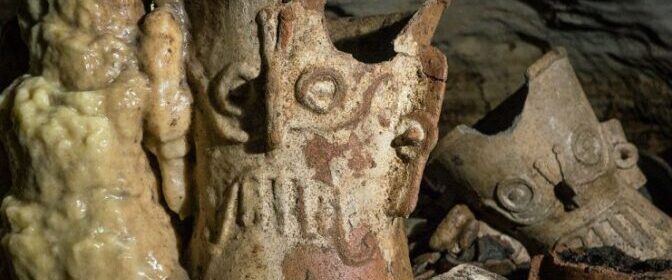Cave Full of Untouched Maya Artifacts Found at Chichén Itzá

Cave Full of Untouched Maya Artifacts Found at Chichén Itzá
Chichén Itzá, a large collection of Maya ruins on the Yucatan Peninsula of Mexico that includes the spectacular El Castillo pyramid, has long been studied and explored by experts.
But as The Associated Press reports, it took a tip or more accurately, two tips—from local residents to guide them to an unexplored cave at the site, which includes hundreds of artefacts, bones and burnt offerings to the gods,

The cave, approximately 1.7 miles east of El Castillo, was first discovered about 50 years ago by locals. At the time, archaeologist Víctor Segovia Pinto was alerted to the discovery.
He ordered the cavern to be sealed and gave a brief report that was soon forgotten. Once again, locals pointed out the place last year to archaeologists, who started investigating again.
Out of respect for local customs, the team—led by archaeologist Guillermo de Anda—performed a six-hour purification ritual before entering the cave system, known as Balamkú or the Jaguar God, Agence France-Presse reports.
Once inside, they belly crawled to reach the seven chambers where the Maya would go to leave offerings, mainly to the central Mexican god of rain, Tlaloc.
To date, researchers have uncovered 155 ceramic incense burners as well as clay boxes and other vessels in the site. They plan to leave the artifacts in situ.
According to Gena Steffens at National Geographic, those associated with the cave rediscovery are all investigators with the Great Maya Aquifer Project, which is working to map the vast network of underground caves, rivers and other water features underneath Mexico’s Yucatan Peninsula.
Last year, the Aquifer project mapped part of an unexplored cave system that turned out to link up with existing system, creating the world’s largest underwater cave system.
It’s a stroke of luck that Pinto decided not to remove the artifacts from the cave all those years ago.
The untouched state of the cave system gives researchers a chance to investigate how much cultural exchange took place between the Maya civilization and other Central American cultures, and perhaps learn more about the Maya before Chichén Itzá went into decline.
Cutting edge 3-D mapping, paleobotany and other recent techniques will all aid in the research effort.

“Balamkú will help rewrite the story of Chichen Itzá, in Yucatán,” de Anda predicted during a press conference held in Mexico City this week.
This is not the only recent discovery at Chichén Itzá.
Archaeologists are hypothesizing that many of the buildings in the archaeological site were built on top of cenotes, or underground lakes.
Researchers are attempting to find and map this subterranean world as part of the Chichén Itzá Underground Project, part of the broader Great Maya Aquifer Project.
In fact, a few years ago, researchers discovered that the El Castillo pyramid itself is built on top of an ancient cenote, and archaeologists have been searching for tunnels that may lead to the hidden, watery lair below the temple.